I have dataframe full of likelihoods from a model I am using to identify points of interest on a set of images. The rows correspond to an image and the columns correspond to a label. There are "Left" and "Right" versions of the labels. I would like to use the split=True keyword to show the L and R sides on the same violin plot.
I have already created separate violin plots for labels "LH1" and "RH1" as can be seen here:
But I am trying to produce a plot with 5 violins, split left and right. Like this example from seaborn:
Seaborn requires a hue parameter which I imagine in my case would be the categorical information "Left" or "Right". As such, I restructured/reshaped my dataframe removing "L" or "R" prefixes in the labels and adding the information as a category under the column "chirality". This is approximately what I have at the moment:
df = pd.DataFrame.from_dict(
{'H1': {0: 0.55, 1: 0.56, 2: 0.46, 3: 0.93, 4: 0.74, 5: 0.35, 6: 0.75, 7: 0.86, 8: 0.81, 9: 0.88},
'H2': {0: 0.5, 1: 0.55, 2: 0.61, 3: 0.82, 4: 0.51, 5: 0.35, 6: 0.58, 7: 0.66, 8: 0.93, 9: 0.86},
'H3': {0: 0.42, 1: 0.51, 2: 0.86, 3: 0.59, 4: 0.46, 5: 0.71, 6: 0.58, 7: 0.72, 8: 0.53, 9: 0.92},
'H4': {0: 0.89, 1: 0.87, 2: 0.04, 3: 0.64, 4: 0.44, 5: 0.05, 6: 0.33, 7: 0.93, 8: 0.08, 9: 0.9},
'H5': {0: 0.92, 1: 0.75, 2: 0.13, 3: 0.85, 4: 0.51, 5: 0.15, 6: 0.38, 7: 0.92, 8: 0.36, 9: 0.76},
'chirality': {0: 'Left', 1: 'Left', 2: 'Left', 3: 'Left', 4: 'Left', 5: 'Right', 6: 'Right', 7: 'Right', 8: 'Right', 9: 'Right'},
'image': {0: 'image_0', 1: 'image_1', 2: 'image_2', 3: 'image_3', 4: 'image_4', 5: 'image_0', 6: 'image_1', 7: 'image_2', 8: 'image_3', 9: 'image_4'}})
H1 H2 H3 H4 H5 chirality image
0 0.55 0.50 0.42 0.89 0.92 Left image_0
1 0.56 0.55 0.51 0.87 0.75 Left image_1
2 0.46 0.61 0.86 0.04 0.13 Left image_2
3 0.93 0.82 0.59 0.64 0.85 Left image_3
4 0.74 0.51 0.46 0.44 0.51 Left image_4
5 0.35 0.35 0.71 0.05 0.15 Right image_0
6 0.75 0.58 0.58 0.33 0.38 Right image_1
7 0.86 0.66 0.72 0.93 0.92 Right image_2
8 0.81 0.93 0.53 0.08 0.36 Right image_3
9 0.88 0.86 0.92 0.90 0.76 Right image_4
# This is what I WANT to do.. but seaborn requires and x and y parameter.
fig, ax = plt.subplots(figsize=(15,6))
sns.set_theme(style="whitegrid")
ax = sns.violinplot(ax=ax,
data=df,
hue='chirality',
split=True)
I've tried many different approaches but I just can't seem to do it. In the attempt above I get ValueError: Cannot use 'hue' without 'x' and 'y' I don't even know what I could set those as despite trying various things and reshaping my dataframe even further. I think I want x as a list of labels, y as the likelihood values and hue to specify L/R.
Any help is appreciated!



